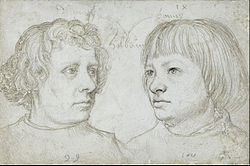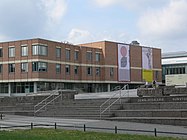Ofbyld:Holbein portrait.png

Grutte fan dit proefbyld: 800 × 527 piksels. Oare resolúsjes: 320 × 211 piksels | 640 × 421 piksels | 1.030 × 678 piksels.
Oarspronklik bestân (1.030 × 678 pixels, bestânsgrutte: 1,22 MB, MIME-type: image/png)
Triemskiednis
Klik op in datum/tiid om it bestân te besjen sa't it op dat stuit wie.
| Datum/Tiid | Miniatuer | ôfmjittings | Meidogger | Opmerking | |
|---|---|---|---|---|---|
| lêste | 15 jun 2006, 17.59 |  | 1.030 × 678 (1,22 MB) | Carlbaratta | Ambrosius and Hans Holbein 1511 Silverpoint on white-coated paper, 10.3 x 15.5 cm Kupferstichkabinett, Staatliche Museen, Berlin Metal Point In medieval times, metal point was used as the primary permanent mark-making tool for both artists and scribes. |
Bestânsgebrûk
De neikommende side brûkt dit bestân:
Globaal bestânsgebrûk
De neikommende oare wiki's brûke dit bestân:
- Gebrûk op arz.wikipedia.org
- Gebrûk op be.wikipedia.org
- Gebrûk op ca.wikipedia.org
- Gebrûk op cs.wikipedia.org
- Gebrûk op el.wikipedia.org
- Gebrûk op en.wikipedia.org
- Gebrûk op es.wikipedia.org
- Gebrûk op fi.wikipedia.org
- Gebrûk op it.wikipedia.org
- Gebrûk op nn.wikipedia.org
- Gebrûk op no.wikipedia.org
- Gebrûk op pl.wikipedia.org
- Gebrûk op pt.wikipedia.org
- Gebrûk op ru.wikipedia.org
- Gebrûk op sh.wikipedia.org
- Gebrûk op sr.wikipedia.org
- Gebrûk op www.wikidata.org



